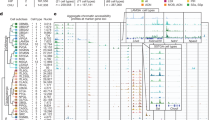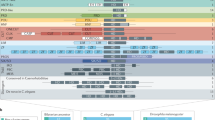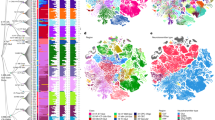Abstract
The mammalian central nervous system (CNS) contains a remarkable array of neural cells, each with a complex pattern of connections that together generate perceptions and higher brain functions. Here we describe a large-scale screen to create an atlas of CNS gene expression at the cellular level, and to provide a library of verified bacterial artificial chromosome (BAC) vectors and transgenic mouse lines that offer experimental access to CNS regions, cell classes and pathways. We illustrate the use of this atlas to derive novel insights into gene function in neural cells, and into principal steps of CNS development. The atlas, library of BAC vectors and BAC transgenic mice generated in this screen provide a rich resource that allows a broad array of investigations not previously available to the neuroscience community.
This is a preview of subscription content, access via your institution
Access options
Subscribe to this journal
Receive 51 print issues and online access
$199.00 per year
only $3.90 per issue
Buy this article
- Purchase on SpringerLink
- Instant access to full article PDF
Prices may be subject to local taxes which are calculated during checkout







Similar content being viewed by others
References
Ramon y Cajal, S. Histology of the Nervous System (Oxford Univ. Press, New York, 1911)
Heintz, N. BAC to the future: the use of BAC transgenic mice for neuroscience research. Nature Rev. Neurosci. 2, 861–870 (2001)
Yang, X. W., Model, P. & Heintz, N. Homologous recombination based modification in Escherichia coli and germline transmission in transgenic mice of a bacterial artificial chromosome. Nature Biotechnol. 15, 859–865 (1997)
Gong, S., Yang, X., Li, C. & Heintz, N. Highly efficient modification of bacterial artificial chromosomes (BACs) using novel shuttle vectors containing the R6Kγ origin of replication. Genome Res. 12, 1992–1998 (2002)
Copeland, N. G., Jenkins, N. A. & Court, D. L. Recombineering: a powerful new tool for mouse functional genomics. Nature Rev. Genet. 2, 769–779 (2001)
Gottlieb, S. et al. The DiGeorge syndrome minimal critical region contains a goosecoid-like (GSCL) homeobox gene that is expressed early in human development. Am. J. Hum. Genet. 60, 1194–1201 (1997)
Gottlieb, S., Hanes, S. D., Golden, J. A., Oakey, R. J. & Budarf, M. L. Goosecoid-like, a gene deleted in DiGeorge and velocardiofacial syndromes, recognizes DNA with a bicoid-like specificity and is expressed in the developing mouse brain. Hum. Mol. Genet. 7, 1497–1505 (1998)
Valjakka, A. et al. The fasciculus retroflexus controls the integrity of REM sleep by supporting the generation of hippocampal theta rhythm and rapid eye movements in rats. Brain Res. Bull. 47, 171–184 (1998)
Emanuel, B. S., McDonald-McGinn, D., Saitta, S. C. & Zackai, E. H. The 22q11.2 deletion syndrome. Adv. Pediatr. 48, 39–73 (2001)
Raper, J. A. Semaphorins and their receptors in vertebrates and invertebrates. Curr. Opin. Neurobiol. 10, 88–94 (2000)
Nakamura, F., Kalb, R. G. & Strittmatter, S. M. Molecular basis of semaphorin-mediated axon guidance. J. Neurobiol. 44, 219–229 (2000)
Chen, H., He, Z. & Tessier-Lavigne, M. Axon guidance mechanisms: semaphorins as simultaneous repellents and anti-repellents. Nature Neurosci. 1, 436–439 (1998)
Takahashi, T., Nakamura, F., Jin, Z., Kalb, R. G. & Strittmatter, S. M. Semaphorins A and E act as antagonists of neuropilin-1 and agonists of neuropilin-2 receptors. Nature Neurosci. 1, 487–493 (1998)
Baird, D. H., Hatten, M. E. & Mason, C. A. Cerebellar target neurons provide a stop signal for afferent neurite extension in vitro. J. Neurosci. 12, 619–634 (1992)
Walz, A., Rodriguez, I. & Mombaerts, P. Aberrant sensory innervation of the olfactory bulb in neuropilin-2 mutant mice. J. Neurosci. 22, 4025–4035 (2002)
Sachs, G. M. & Schneider, G. E. The morphology of optic tract axons arborizing in the superior colliculus of the hamster. J. Comp. Neurol. 230, 155–167 (1984)
Sachs, G. M., Jacobson, M. & Caviness, V. S. Jr. Postnatal changes in arborization patterns of murine retinocollicular axons. J. Comp. Neurol. 246, 395–408 (1986)
Edwards, M. A., Caviness, V. S. Jr & Schneider, G. E. Development of cell and fiber lamination in the mouse superior colliculus. J. Comp. Neurol. 248, 395–409 (1986)
Edwards, M. A., Schneider, G. E. & Caviness, V. S. Jr. Development of the crossed retinocollicular projection in the mouse. J. Comp. Neurol. 248, 410–421 (1986)
Brown, A. et al. Topographic mapping from the retina to the midbrain is controlled by relative but not absolute levels of EphA receptor signaling. Cell 102, 77–88 (2000)
Feldheim, D. A. et al. Genetic analysis of ephrin-A2 and ephrin-A5 shows their requirement in multiple aspects of retinocollicular mapping. Neuron 25, 563–574 (2000)
Yates, P. A., Roskies, A. L., McLaughlin, T. & O'Leary, D. D. Topographic-specific axon branching controlled by ephrin-As is the critical event in retinotectal map development. J. Neurosci. 21, 8548–8563 (2001)
Anderson, S. A., Eisenstat, D. D., Shi, L. & Rubenstein, J. L. R. Interneuron migration from basal forebrain to neocortex dependence on Dlx genes. Science 278, 474–476 (1997)
Marin, O. & Rubenstein, J. A long, remarkable journey: tangential migration in the telencephalon. Nature Rev. Neurosci. 2, 780–790 (2001)
Hatten, M. New directions in neuronal migration. Science 297, 1660–1663 (2002)
Lavdas, A. A., Grigoriou, M., Pchnis, V. & Rubernstein, J. G. The medial ganglionic eminence gives rise to a population of early neurons in the developing cerebral cortex. J. Neurosci. 19, 7881–7888 (1999)
Ross, C., MacCumber, M., Glatt, C. & Snyder, S. Brain phospholipase C isozymes: differential mRNA localizations by in situ hybridization. Proc. Natl Acad. Sci. USA 86, 2923–2927 (1989)
Rybalkin, S., Rybalkina, I., Beavo, J. & Bornfeldt, K. Cyclic nucleotide phosphodiesterase 1C promotes human arterial smooth muscle proliferation. Circ. Res. 90, 151–157 (2002)
Meyer, G., Soria, J. M., Martinez-Galan, J. R., Martin-Clemente, B. & Fairen, A. Different origins and developmental histories of transient neurons in the marginal zone of the fetal and neonatal rat cortex. J. Comp. Neurol. 397, 493–518 (1998)
Derer, P. & Derer, M. Cajal-Retzius cell ontogenesis and death in mouse brain visualized with horseradish peroxidase and electron microscopy. Neuroscience 36, 839–856 (1990)
D'Arcangelo, G. et al. Reelin is a secreted protein recognized by the CR-50 monoclonal antibody. J. Neurosci. 17, 23–31 (1997)
Wang, X., Zhong, P. & Yan, Z. Dopamine D4 receptors modulate GABAergic signaling in pyramidal neurons of prefrontal cortex. J. Neurosci. 22, 9185–9193 (2002)
Frantz, G., Weimann, J., Levin, M. & McConnell, S. Otx1 and Otx2 define layers and regions in developing cerebral cortex and cerebellum. J. Neurosci. 14, 5725–5740 (1994)
Weimann, J. et al. Cortical neurons require Otx1 for the refinement of exuberant axonal projections to subcortical targets. Neuron 24, 819–831 (1999)
Nicola, S., Surmeier, J. & Malenka, R. Dopamine modulation of neuronal excitability in the striatum and nucleus accumbens. Annu. Rev. Neurosci. 23, 185–215 (2000)
Le Moine, C. & Bloch, B. D1 and D2 dopamine receptor gene expression in the rat striatum: sensitive cRNA probes demonstrate prominent segregation of D1 and D2 mRNAs in distinct neuronal populations of the dorsal and ventral striatum. J. Comp. Neurol. 355, 418–426 (1995)
Surmeier, J., Song, W.-J. & Yan, Z. Coordinated expression of dopamine receptors in neostriatal medium spiny neurons. J. Neurosci. 16, 6579–6591 (1996)
Hersh, S. et al. Electron microscopic analysis of D1 and D2 dopamine receptor proteins in the dorsal striatum and their synaptic relationships with motor corticostriatal afferents. J. Neurosci. 15, 5222–5237 (1995)
Bernard, V., Levey, A. & Bloch, B. Regulation of the subcellular distribution of M4 muscarinic acetyl choline receptors in striatal neurons in vivo by the cholinergic environment: evidence for regulation of cell surface receptors by endogenous and exogenous stimulation. J. Neurosci. 19, 10237–10249 (1999)
Gerfen, C. R. & Young, W. S. III Distribution of striatonigral and striatopallidal peptidergic neurons in both patch and matrix compartments: an in situ hybridization histochemistry and fluorescent retrograde tracing study. Brain Res. 460, 161–167 (1988)
Lee, E. C. et al. A highly efficient Escherichia coli-based chromosome engineering system adapted for recombinogenic targeting and subcloning of BAC DNA. Genomics 73, 56–65 (2001)
Muyrers, J. P., Zhang, Y., Testa, G. & Stewart, A. F. Rapid modification of bacterial artificial chromosomes by ET-recombination. Nucleic Acids Res. 27, 1555–1557 (1999)
Metcalf, W. W. et al. Conditionally replicative and conjugative plasmids carrying lacZα for cloning, mutagenesis, and allele replacement in bacteria. Plasmid 35, 1–13 (1996)
Paxinos, G. & Franklin, K. The Mouse Brain in Stereotaxic Coordinates 132 (Academic, San Diego, 2001)
Valverde, F. Golgi Atlas of the Postnatal Mouse Brain (Springer, Vienna, 1998)
Schambra, U., Lauder, J. & Silver, J. Atlas of the Prenatal Mouse Brain (Academic, San Diego, 1992)
Acknowledgements
We are grateful to the staff of GENSAT who generated this data, including C. Grevstad, A. Sung, P. Dyer, H. Zhu, S. M. Ehta, C. Wang, T. Allanson, C. Madden, Y. Huang, H. Sherman and H. Feng; to N. Adams who helped to write the macros for the image-acquisition system and who provided advice on histological methods; to D. Birchfield and B. Dittmer-Roche who helped to write the database programs; and to J. Walsh who helped with the preparation of the manuscript. The GENSAT project is supported by grants from the National Institutes of Health. N.H. and A.J. are investigators of the Howard Hughes Medical Institute.
Author information
Authors and Affiliations
Corresponding authors
Ethics declarations
Competing interests
The authors declare that they have no competing financial interests.
Rights and permissions
About this article
Cite this article
Gong, S., Zheng, C., Doughty, M. et al. A gene expression atlas of the central nervous system based on bacterial artificial chromosomes. Nature 425, 917–925 (2003). https://doi.org/10.1038/nature02033
Received:
Accepted:
Issue Date:
DOI: https://doi.org/10.1038/nature02033



